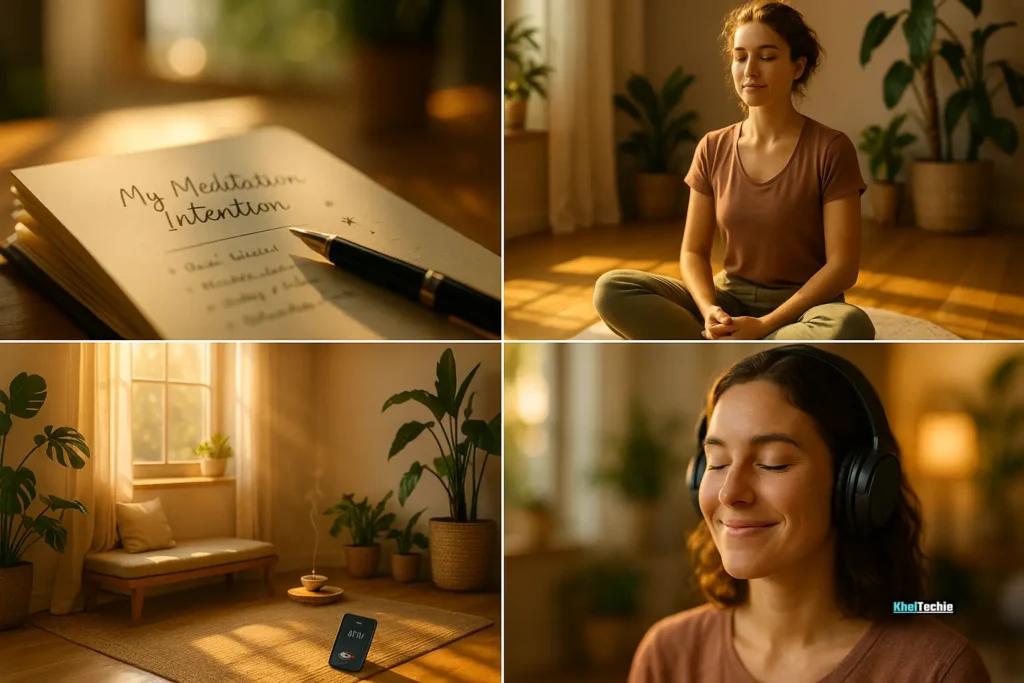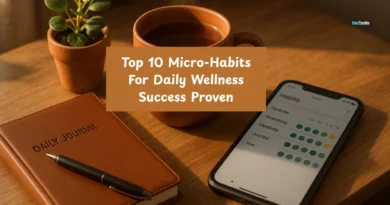How to Build a Sustainable Meditation Habit (Even If You’ve Tried and Failed Before)
Why Your Meditation Journey Keeps Fizzling Out
You’ve tried it before – downloaded an app, sat quietly for 5 minutes and told yourself, “This is it, I’m going to be the kind of person who meditates every day.” But then life happened. Work got hectic, You forgot your morning routine. You felt like you weren’t “doing it right.” And just like that… your meditation habit vanished.
If this sounds familiar, you’re not alone.
Don’t beat yourself up. Building a sustainable meditation habit is harder than most people admit, but it’s absolutely possible. In this guide, you’ll discover exactly how to build a meditation habit you can sustain for life, even if you’ve tried and failed a dozen times before. Let’s unravel the secrets together, one mindful breath at a time.
Also read – How to Improve Mental Health with Fitness

What Is a Sustainable Meditation Habit?
A sustainable meditation habit is a consistent, personalized and realistic practice that becomes part of your daily life, without feeling forced or overwhelming like brushing your teeth or grabbing your morning coffee.
Think of it like training a puppy:
- If you train inconsistently, the puppy forgets the rules.
- If you train it gently and consistently, the puppy learns.
Your mind is the puppy here. Meditation trains it to stay, sit and calm down.
Here’s how you’ll know your habit is sustainable:
- You do it almost daily without having to force yourself.
- You look forward to it (or at least don’t dread it).
- You notice benefits in your daily life like less stress, more focus, a calmer mood.
- You bounce back quickly if you miss a day.

Why Building a Sustainable Meditation Habit Matters
In today’s fast-paced world, building a sustainable meditation habit isn’t just a lifestyle choice, it’s a lifeline. Imagine this, just seven minutes of meditation daily can transform your mind, making you more resilient to stress and empowering you to make choices that are good for you and the planet. Recent research shows that meditation strengthens the part of your brain responsible for rational thinking and planning, helping you cut through the noise of misinformation and act with clarity, even in the face of climate anxiety or overwhelming news feeds
But the story doesn’t end there. As we step into 2025, meditation is being recognized globally as an essential tool for navigating the complexities of modern life. It’s not just about relaxation anymore; it’s about evolving as individuals and as a society. Meditation bridges the gap between ancient wisdom and cutting-edge science, offering a proven path to self-awareness, emotional stability and inner peace. This inner transformation spills over into our relationships, our work and even the way we interact with the environment. Experts now call meditation a cornerstone for personal and collective growth, a habit as fundamental as brushing your teeth
The uniqueness of meditation lies in its simplicity and power. You don’t need fancy equipment or hours of free time. What matters is consistency, showing up for yourself, even if it’s just for a few minutes each day. As more companies and communities embrace meditation, it’s clear that this habit isn’t just about personal wellness, It’s about building a future where clarity, compassion and sustainability go hand in hand. So, why not start today? Your mind and the world of thinking will graciously improve.

How to Build a Sustainable Meditation Habit (Step-by-Step)
Let’s break it down into simple, actionable steps that anyone can follow, even if you’ve failed before.
Step 1: Set a Clear Intention (Not Just a Goal)
Goals are great, but intentions go deeper.
Ask yourself:
- Why do I want to meditate?
- What does success look like for me?
Maybe you want to reduce stress, sleep better or improve focus. Whatever it is, write it down. This will become your anchor when motivation wanes.
Use the SMART framework (Specific, Measurable, Achievable, Relevant, Time-bound) for goals and pair them with a meaningful intention.
Step 2: Start Small = Really Small
A surefire way to fail is deciding you’ll meditate for 30 minutes a day right from the start.
Instead, start tiny Like, may be just two minutes.
- Set a timer for two minutes.
- Sit comfortably. You don’t have to twist into a pretzel.
- Focus on your breath or just notice sounds around you.
- When the timer dings, you’re done.
This removes mental resistance. You’ll often keep going longer because starting is the hardest part.
Step 3: Pick a Time That Works for You
Consistency beats intensity, Choose a specific time each day for your meditation. Most people find mornings work best, but if you’re a night owl, try winding down with a short session before bed.
Use calendar reminders or set alarms to build the habit loop.
Step 4: Create a Dedicated Space
You don’t need a fancy meditation room, but having a small, quiet corner helps.
Place a cushion, a candle or a plant there, something that signals to your brain, “This is my space for peace.” Even sitting on your bed or couch counts, as long as it feels intentional.
Step 5: Use Guided Meditations (Especially at First)
Apps like Headspace, Calm and Insight Timer offer beginner-friendly guided sessions that walk you through breathing techniques and mindfulness exercises.
They help you stay focused and give you structure, especially useful when your mind wanders (which it will).
Step 6: Track Your Progress
Tracking builds accountability. Use a habit tracker app, journal or even a simple checklist. Seeing progress, even just a few checkmarks motivates you to keep going.
Here’s a simple tracking table:
| Date | Duration | Notes |
|---|---|---|
| July 7 | 5 min | Felt calm after |
| July 8 | 5 min | Distracted, but finished |
| July 9 | 5 min | Better focus |
Step 7: Embrace Imperfection
Meditation isn’t about silencing your thoughts. It’s about noticing them without judgment and gently returning your focus. Some days will feel amazing. Others, you might barely make it through two minutes. That’s okay.
The key is showing up, not being perfect.
Step 8: Pair It With an Existing Habit
Use the power of habit stacking. Pair your meditation with something you already do daily, like:
- After waking up
- Before brushing your teeth
- Right after your coffee
- After your lunch break
- Before checking social media
This makes it easier to remember and integrate naturally into your routine.
Step 9: Make It Enjoyable
If you dread your meditation time, you won’t stick with it. Try different types of meditation until you find what resonates:
- Body scan
- Loving-kindness (metta)
- Breath awareness
- Visualization
- Guided meditations
- Walking meditation
You can also play calming music or nature sounds in the background.
Step 10: Stay Accountable
Meditation can feel lonely if you’re going it alone. Tell a friend about your goal or join online communities for support.
Some great places:
- r/Meditation on Reddit: https://www.reddit.com/r/Meditation/
- Insight Timer Community: https://insighttimer.com
Accountability increases commitment and sometimes, just knowing someone else is doing it too keeps you motivated.

Common Mistakes That Kill Meditation Habits
Even with good intentions, many people fall into traps that sabotage their progress. Here are the top ones to avoid:
1. Expecting Immediate Results
Meditation is like strength training for the mind, It takes time. Don’t expect instant calm or enlightenment. Be patient.
2. Trying Too Hard
Trying to “force” stillness often leads to frustration. Let go of expectations and allow the process to unfold naturally.
3. Skipping Days Without a Plan to Resume
Missing a day isn’t failure, but skipping multiple days without a reset plan is. If you miss a session, simply return the next day without guilt.
4. Using Meditation as an Escape
Meditation isn’t about avoiding problems. It’s about facing them with clarity and resilience. Don’t use it to numb emotions, use it to understand them.
5. Not Tailoring the Practice to Your Lifestyle
There’s no one-size-fits-all approach. If sitting still isn’t your thing, try walking meditation or mindful movement like yoga.
Also read – Top 10 Micro-Habits for Daily Wellness Success

Conclusion: Start Small, Stay Consistent To Transform Your Life
Building a sustainable meditation habit isn’t about being perfect, It’s about being persistent. Start with just a few minutes a day. Show up even when you don’t feel like it. Celebrate small wins And remember, you’re not trying to silence your mind; you’re learning to relate to it differently.
If this article helped you, leave a comment below sharing your meditation journey. Did you try any of these steps? What worked or didn’t? Let’s grow together And if you found value here, hit that share button. Someone you know might be struggling to start their meditation journey and this could be the push they need.
This article is for informational purposes only and does not substitute professional medical or psychological advice. Always consult a qualified healthcare provider before starting any new wellness, mental health, or meditation practice, especially if you have existing health conditions.
FAQs About Building a Sustainable Meditation Habit
How long should I meditate each day to build a habit?
Start with just 2–5 minutes a day. Once it becomes a routine, you can slowly increase to 10, 15 or 20 minutes.
Can I meditate lying down?
Yes, especially if you have physical limitations. However, some people fall asleep when lying down, so sitting upright may help maintain alertness.
What should I do when my mind keeps wandering?
It’s completely normal. Gently bring your attention back to your breath or chosen focus point. Every time you notice your mind wandering and return, you’re strengthening your mindfulness muscle.
What’s the easiest meditation for beginners?
Simple breath meditation:
- Sit comfortably
- Focus on your breathing
- Gently return to your breath if your mind wanders
That’s it!
Do I need special equipment?
No, All you need is a quiet space and a few minutes. However, using a cushion, meditation bench or a calming app can enhance your experience.
How do I know if I’m meditating correctly?
If you’re showing up and trying—you’re doing it right. There’s no “perfect” way to meditate. Focus on consistency, not perfection.
Can I meditate with noise around me?
Absolutely, Background noise like traffic or conversations is common, especially in urban settings. Try using earplugs, white noise or apps with ambient sounds.
Should I meditate before or after exercise?
Both can work! Meditate before to center your mind before working out, or after to cool down and reflect.
Can I meditate during stressful times?
Yes & it’s encouraged. Meditation helps you respond to stress rather than react impulsively. Even a 2-minute breathing exercise can make a difference.
Is it okay to cry during meditation?
Yes, Emotions can surface during meditation and that’s healthy. Allow them to flow without judgment. Crying is a natural release and part of healing.
How do I make meditation less boring?
Try new techniques like walking meditation
Shorten your sessions
Use gentle background music
Join a group for accountability
Can meditation replace therapy?
No, Meditation complements therapy but doesn’t replace professional help for trauma or serious mental health issues.
How long does it take to see results from meditation?
Many people report feeling calmer and more focused within 4-6 weeks of daily practice. For lasting benefits like improved emotional regulation and reduced anxiety, aim for at least 10 weeks.




